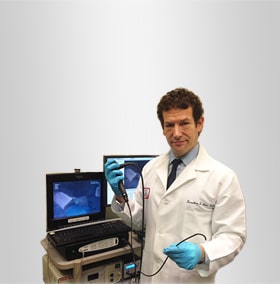
TNE (TransNasal Esophagoscopy) is the state-of-the-art medical procedure performed on wide awake patients to examine the esophagus to identify any problem there including complications from acid reflux disease, potentially pre-cancerous lesions such as Barrett esophagus, and even esophageal cancer. TNE does not require intravenous sedation, but it does require a small amount of numbing and decongestant medicine misted into the nose.
TNE is more than simply inserting a tiny flexible camera into the esophagus. The physician performing a TNE is also examining the inside of the nose and sinuses to make sure there is no significant sinus or allergy disease on the way down through the pharynx towards the larynx. While in the pharynx, the clinician makes sure there are no tumors on the tongue and in the throat. A key portion of the procedure is to then examine the vocal fold area for signs of Throatburn Reflux disease. The esophagus is then entered and examined entirely, including the bottom portion of the esophagus and the top portion of the stomach. In many cases, biopsies of the esophagus are performed during a TNE.
It is important to reiterate that when no intravenous medication is required for any medical procedure, including TNE, the procedure becomes much safer. Monitoring of the patient’s heart rate or blood pressure or oxygen levels is not required, and there is minimal recovery time. Patients can instantly resume what they were doing before the exam.
MYTH #1: TNE is not as well tolerated as conventional endoscopy (EGD).
FACT: From 1996 until now, there have been numerous studies comparing TNE and EGD, demonstrating that patients can tolerate a camera in their nose as well as they tolerate a camera in their mouth.
MYTH #2: TNE is not as effective as EGD.
FACT: Unsedated TNE has demonstrated equal accuracy in the detection of Barrett esophagus when compared with conventional, sedated, transoral upper endoscopy.
MYTH #3: TNE is expensive.
FACT: TNE is one-fifth the cost of EGD.
MYTH #4: TNE will increase our national health care costs.
FACT: TNE can save the health care industry about $5 billion per year.
MYTH #5: TNE has side effects.
FACT: Beyond the potential for a nosebleed, TNE is exceedingly safe.
The TNE procudure is videotaped so the physician not only has a record of the exam, but can, literally, frame by frame, go over everything with the patient.
If you would like to read about the proper way to administer a TNE examination, as well as a more detailed explanation of TNE and its indications for patients, please click here.
If you feel you are a candidate for a TNE examination, please click here.
As a result of the need to assess sensation during swallowing, Dr. Aviv developed FEESST (Flexible Endoscopic Evaluation of Swallowing with Sensory Testing), a method and device which measures sensitivity in the throat.
FEESST is a technique used to directly examine both the motor and sensory functions of swallowing so that proper treatment can be given to patients with swallowing difficulties to decrease their risk of aspiration (food and liquids going into the lungs instead of the stomach) and choking.
The assessment of swallowing function not only has applications to determine a post-operative patient’s swallowing status, but also has relevance in many other areas of medicine where swallowing impairment takes place. This includes acute stroke, as well as diseases such as Parkinson’s, Multiple Sclerosis, Amyotrophic Lateral Sclerosis (Lou Gehrig’s disease), as well as other chronic neurological conditions.
While performing FEESST on patients, whether with chronic neurological diseases or post-operative patients recovering from head and neck cancer operations, Dr. Aviv noticed that their condition was often exacerbated by the swelling of their larynx due to acid reflux damage. By treating the acid reflux problem, Dr. Aviv found that their swallowing problems began to improve. Following my development of FEESST (1993), Dr. Aviv began to notice a dramatic increase in the overall number of patients who were experiencing acid reflux but went undiagnosed until he performed the FEESST procedure on them. As a result, FEESST became important in diagnosing severe cases of Throatburn Reflux (acid reflux with the patient complaining of throat symptoms such as cough, hoarseness, lump-like sensation in the throat, swallowing difficulty, and/or throat burning, wothout having heartburn), where swallowing and throat sensitivity had been drastically impaired.
Thus, a procedure that was originally intended to measure sensation in a person’s throat became a diagnostic tool to diagnose acid reflux disease.
FEESST was invented by Dr. Aviv in 1993, and has been used by otolaryngologists (ear, nose and throat doctors), pulmonologists (lung doctors), gastroenterologists (stomach and digestion doctors), intensivists (intensive care specialists) and speech-language pathologists for the past 20 years.
If you are a medical professional and would like to read about the proper way to administer a FEESST examination, please click here.
If you feel you are a candidate for a FEESST examination, please click here.